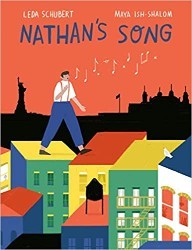Based on years of field study, interviews, and participation in the downtown scene about which she writes, Tamar Barzel presents a scholarly and often highly technical account of the emergence of what she calls “a radical Jewish culture” moment among musicians on New York’s Lower East Side in the late 1980s and early 1990s. At this time, artists like John Zorn, Sharon Topper, Anthony Coleman, and Shelley Hirsch began to express their Jewish heritage and identities through their compositions and performance pieces. Their “moment” reached its apogee in the Radical Jewish Cultural Festival organized by John Zorn, in of all places, Munich, Germany, in 1992 and then mounted closer to home at the group’s unofficial headquarters, the Knitting Factory.
Part of a scholarly musicology monograph series, “Profiles in Popular Music,” the book’s chief focus is on analysis of the compositions of these musicians. A good deal of this analysis may not be fully accessible to the non-trained reader (even with the use of the accompanying website of examples), but Barzel’s chapters on the origins and development of this radical Jewish music ably and clearly present, in a form many interested readers can negotiate (an occasional indulgence in academic jargon notwithstanding), the provocative issues of the roles of identity, ethnicity, and creativity that the musicians themselves interrogated in their art.
Barzel suggests in her introduction and two overview chapters that part of the impetus for this ethnic awakening came from a general turn toward identity politics and aesthetics in the 1980s, particularly among hip-hop and other black American artists. For many Jewish musicians, the turn toward an identifiable “Jewish” music was often a fraught experience. Many of them grew up in post-war assimilated homes where identification as a Jew was discouraged. Their ethnic identification had been shrouded in “a thick silence,” as Barzel calls it. What did Jewish music mean to them? Traditional genres of Jewish music — Klezmer or classical Chazzanut—were devalued or scorned. These were musicians more at home with rock, jazz, blues, punk, and Latin American forms.
Zorn seems to have been a catalyst in bringing to the fore the issues of Jewish identity, but others were also moving in that direction. The Klezmer revival (or “renaissance,” as Barzel prefers to call it) was at its height, and many musicians worked on their avant-garde compositions and dabbled in Klezmer, often creating blendings that pushed the sonic environment to new limits (many examples of this music are not easy listening!).
But the radical moment was not merely a matter of fusing avant-garde with Klezmer or other Jewish musical genres, Barzel argues. It became a matter of interrogating the forms of Jewish music themselves as a means of interrogating identity itself, not just religious and ethnic but sexual, as well. Barzel provides extensive examples of how Zorn, Topper, Hirsch, and Coleman, in her words, challenged “established ideas about the nature of musical composition” and “argued for a new relationship between creativity and identity, thereby proposing a new template for ‘composing’ notions of Jewish identity and tradition.” Some readers may not be convinced that this music does what Barzel claims it does, but her argument is as provocative as the music and the account is a welcome addition to the literature on contemporary Jewish identity politics.
Bibliography; musical illustrations; notes; photographs. (A website of musical examples will be also be available online.)
Related content:
Tamar Barzel’s Visiting Scribe Posts
A Jewish Music Koan: What is the Sound of a Klezmer Band Not Playing?





